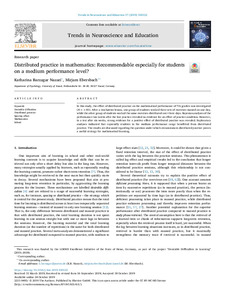| dc.date.accessioned | 2021-08-03T16:21:15Z | |
| dc.date.available | 2021-08-03T16:21:15Z | |
| dc.date.issued | 2019-10-24 | |
| dc.identifier | doi:10.17170/kobra-202103253597 | |
| dc.identifier.uri | http://hdl.handle.net/123456789/13071 | |
| dc.description.sponsorship | This research was funded by the LOEWE Excellence Initiative of the State of Hesse, Germany, as part of the project “Desirable Difficulties in Learning” (2015–2018) | eng |
| dc.language.iso | eng | eng |
| dc.rights | Attribution-NonCommercial-NoDerivatives 4.0 International | * |
| dc.rights.uri | http://creativecommons.org/licenses/by-nc-nd/4.0/ | * |
| dc.subject | desirable difficulties | eng |
| dc.subject | distributed practice | eng |
| dc.subject | spacing effect | eng |
| dc.subject | mathematics | eng |
| dc.subject | school | eng |
| dc.subject.ddc | 150 | |
| dc.title | Distributed practice in mathematics: Recommendable especially for students on a medium performance level? | eng |
| dc.type | Aufsatz | |
| dcterms.abstract | In this study, the effect of distributed practice on the mathematical performance of 7th graders was investigated (N == 81). After a stochastics lesson, one group of students worked three sets of exercises massed on one day, while the other group of students worked the same exercises distributed over three days. Bayesian analyses of the performance two weeks after the last practice revealed no evidence for an effect of practice condition. However, in a test after six weeks, strong evidence for a positive effect of distributed practice was revealed. Exploratory analyses indicated that especially students in the medium performance range benefitted from distributed practice. The results are discussed regarding the question under which circumstances distributed practice proves a useful strategy for mathematical learning. | eng |
| dcterms.accessRights | open access | |
| dcterms.creator | Barzagar Nazari, Katharina | |
| dcterms.creator | Ebersbach, Mirjam | |
| dc.relation.doi | doi:10.1016/j.tine.2019.100122 | |
| dc.subject.swd | Mathematikunterricht | ger |
| dc.subject.swd | Lerntechnik | ger |
| dc.subject.swd | Experimentelle Psychologie | ger |
| dc.type.version | publishedVersion | |
| dcterms.source.identifier | eissn:2211-9493 | |
| dcterms.source.identifier | issn:2452-0837 | |
| dcterms.source.journal | Trends in Neuroscience and Education | eng |
| dcterms.source.volume | Volume 17 | |
| kup.iskup | false | |
| dcterms.source.articlenumber | 100122 | |


